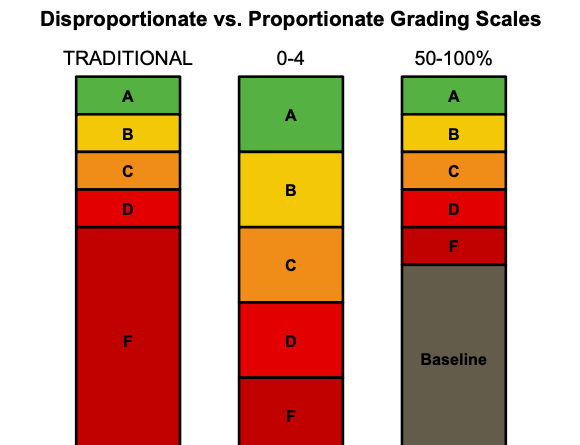CVUSD proposes mandatory proportional grading
CVUSD is in the process of requiring teachers to adopt proportional grading practices. According to a statement supplied by Assistant Superintendent Nia Rashidchi, district officials believe “past grading practices do not accurately reflect student learning, are subject to implicit bias, are not motivational for all students, and do not support a growth mindset mantra.” The proposed policy gives teachers two options: adopt a 0-4 grading scale or a 50-100% grading scale.
Because the traditional grading scale has a 0-59% range for an F and 10% ranges for the other four letter grades, zeroes can disproportionately weigh down a student’s average grade. Proportional scales eliminate this effect by dividing letter grades into equal ranges, and it also seeks to reduce the impact on grades from influences outside of a student’s control, such as biased teacher judgment and life circumstances.
“I am in support of proportional grading because I will be able to do less homework and still maintain a passable grade,” said senior Edison Huang. “Homework is tedious and I have obligations outside of school, including extracurriculars.”
However, others consider the measure to be harmful.
“I believe instead of making low grades have less effect on overall grades, unlimited retakes is the more helpful aspect behind proportional grading–at least in 0-4 scale grading–since it teaches students to put effort in,” said senior Michelle Li.
In a survey of 104 CVHS teachers, 47.1% of teachers use a 0-4 grading scale, but 60.6% of them disagree with the district making it mandatory.
Many teachers dislike the district’s handling of the policy, saying that there is insufficient time and training to implement such practices correctly. Some believe that teachers should be the ones to decide instead of the district making it mandatory.
The support for proportional grading is often divided by subject. For example, the majority of the social studies department is against the proposed changes.
In the same survey, 82.7% oppose a mandatory 50-100% scale, which would make a 50% the minimum enterable grade instead of a zero. Its purpose is the same as the 0-4 scale: making the grades equally proportioned. Scores would be inflated to match the scale, so half credit on an assignment would translate to a 75%, being a C.
A large concern is with the impression of a student receiving 50% credit on an assignment when it actually corresponds to a zero, which can send confusing messages.
“The 50% floor is a really problematic way of implementing a proportional grading scale, but I do really like the four point scale or an F being from zero to 20% so that we don’t reward Fs and Ds over missing assignments,” said English teacher Trenton Logan.
With either proportional grading scale, zeroes impact a grade less. For example, if students are assigned two assignments and have a disproportionate grading scale, a student that gets an A on one assignment and does not turn in the other will have an F, while a student that gets a B and a D on the assignments will have a C. With proportional grading, both students earn a C.
Proportional grading prioritizes grading solely on academic knowledge and learning, but one concern is the lack of incentive and the fact that these practices are not very prevalent in college or in jobs. Although the district claims that “colleges often emphasize mastery of content and critical engagement over test performance alone” and that “by aligning high school grading systems with these principles, students can transition more smoothly into higher education environments,” some teachers disagree.
“I am deeply concerned that giving a 50% for zero work will significantly harm the learning process and send students out into the world at a disadvantaged position,” said social studies teacher Sarah Burke. “I see this as a violation of the trust that students’ parents in the community have put in us to educate the youth.”


I think there’s definitely some idealization in the effectiveness of the idea, but I think overall it’s a good step forward. A lot of people say that there’ll be less classwork to do which will in turn make people lazier, as though it’s the only factor affecting students’ laziness. The current system doesn’t exactly encourage students to not not be lazy either, it’s just that this proposed system will relieve a bit of the stress that students find themselves in after mismanaging things. It’s not THE solution, but it’s definitely part of the growing effort to achieve reform.